Breathe, just breathe...
On the inside I was panicking as I thought about all of the things I use my computer, projector, document camera, and smartboard for... all the lessons I had ready to go for the smartboard today! But there was nothing I could do about it and getting upset or frazzled would not help.
In adjusting my RTi lesson I went back to the books, Reading with Meaning by Debbie Miller, to be exact. I skimmed through the chapter on "Inferring" and silently checked off the inferring we had already practiced:
*what does inferring mean
*Inferring word meanings
*Inferring character traits
And that brought me to Readers use their prior knowledge and textual clues to draw conclusions and form unique interpretations of text (page 111). That sounded fun! One of the teaching strategies for this was inferring with poetry. I recreated a document shown in her book (Figure 8.6) and had my lesson ready to go!
Having the low group for this RTi skill means I have to work to really break things down into small and manageable parts. So planning on spending an entire 30-minute lesson on one worksheet seems a little under-ambitious, but it was the perfect activity for our group. We had enough time to read through the poem slowly, line by line, discussing the inferences my students came up with and determining together if it is a valid inference or not. For example, one student inferred the animal in the poem was a lizard. I asked why, he said because they jump in the air! I then read the line I swim in the sea from the poem, and he smiled with an ohhhhhhhhhh look on his face :)
Below is the wonderful list of animals my students came up with:
Dolphin
Eel
Fish
Whale
Shark
Octopus
and one student even suggested a remipede (never heard of it before today!)
Every one of my eight students came to a valid inference with wonderful reasons why. The best part was as I walked around and glued their worksheet and picture to a large piece of construction paper and I asked each student why he (all of my students are boys in my group) inferred the animal he did, they easily gave me the sentence from the poem that matched their chosen animal's characteristics.
Overall this was a great lesson! I really felt like every one of my student's completely understood what inferring meant. We ended the lesson by talking about how there really isn't a perfect answer for what animal this poem is talking about, that there are lots of answers that we came up with today that fit! And that is exactly what good readers do, we infer, we figure out what fits, and sometimes that means more than one answer.
For tomorrow's lesson I will be using the smartboard again, YAY!!! (my Smartboard became functional at about 1:30 pm today) I found two short poems, one about a monkey and the other about a snake. I omitted the animal names in each poem and we will use our inferring skills to figure them out together.
Then I have a special inferring activity that involves 5 things in my purse...


















